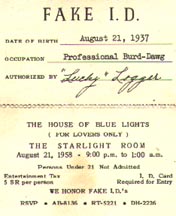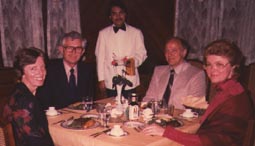 |
The Tri-D Dance was the biggest event of the summer. Old friendships rekindled and students had a chance to talk about summer employment and prospects for the future. It was a good time to see and meet new kids. ARAMCO always allowed their professional facilities to be used for student activities. These fake ID tickets were typeset and printed at company expense. ARAMCO employees jumped at the chance to help the kids have fun. Parties usually preceded or followed the Tri-D. Most students stayed over night and sampled the hospitality of the host community. Each community tried to outdo the others. Most kids rode the district bus between communities. It was free. |
|||||||||
| In the early 1980s, the dining hall was still an important social center. I noticed my boss having breakfast with his boss on numerous occasions. There were some changes. The bathrooms off the foyer were now Eastern and Western style, and a small, exclusive dining room was set aside at the far end of the east room. It was carpeted, used overstuffed furnishings, and the waiters were attired with tie and jacket. The room was dark and tastefully decorated. There were even fresh cut flowers now that a shop owner in al Khobar received regular air express shipments from Amsterdam. | ||||||||||
 |
||||||||||
| Bill and Janine Larson join Clarice and the author for an exclusive dinner at the Dhahran dining hall in 1982. The company was approaching its fiftieth anniversary and many changes were occurring as Saudis played an increasing role in management as Americans were replaced. | ||||||||||
|
The dining hall has been refurbished several times over the years. In the main dining rooms, digital cash systems replaced the old cash registers, but bills were still rung up the old way. The cash drawer was left open and after the cashier rang up the sale, he just dipped into the till to store cash and make change. This practice is frowned on in the West since it reduces the integrity of the sale. If the drawer is left open, the operator can still ring up the sale but instead of totaling it, he can hit clear after change is made and no record of the transaction will remain. Another change at the dining hall was in the parking lot. We could get our car washed while we ate. Numerous contract workers hung around parking lots to make extra cash. This is a major change, since in the early days almost no ARAMCO employees owned their own cars. In the 1980s, however, most employees owned a car, with General Motors products being the most popular.
|
||||||||||
|
Copyright ©1999-2006 Rolf A.
Christophersen |
||||||||||